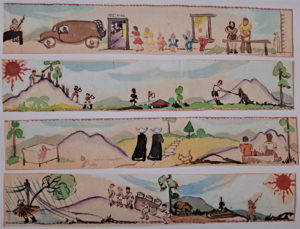Prison Artist Credits

Fern Harrington Miles (1914-2006) sketched the cover art in 1942 while she was imprisoned at Camp Holmes along with the Crouters. Miles was a missionary living in China who on the advice of the U.S. Embassy in Beijing moved to Baguio to avoid being interned by the Japanese. In her book, Captive Community, she wrote, “In reality, instead of a haven as American territory, the Philippines was a prime Japanese target.”
(Artwork courtesy of the MacArthur Memorial Archives.)

Daphne Bird (1912-1994) was interned with Natalie Crouter. The picture shows Daphne (red hair), a friend and their children the morning of December 8, 1941 eating breakfast at the Camp John Hay dining room when the first bombs dropped on the Philippines. In 2014, her son, Derek Bird, recalled the following:
“My parents got engaged in Shanghai and were married in Hong Kong in the mid 1930s, where they started married life. I was born on July 13, 1939. At this time the war in Europe was a distant anxiety, but the Japanese had invaded China, and Hong Kong was threatened. Due to [my father’s] previous service with the London Irish Rifles, he was called up, and commissioned as a Captain in the Royal Engineers. In 1940, my mother, Daphne and I were evacuated to Melbourne, Australia with [two other wives and their children]. All the three husbands remained in Hong Kong.
The three were to be sent for a Staff College course in Burma, and were given two weeks’ leave. They contacted their wives and agreed that all three families would meet at the Baguio Country Club in the North of the Philippines. This duly went ahead, and all met in Baguio late in 1941. The men received a signal from Hong Kong, cancelling the staff course, and they were ordered to return to Hong Kong forthwith. The wives and two children were to await a ship to take them back to Melbourne. However, December 7th brought the Japanese attack on the US naval base in Pearl Harbour in Hawaii; the surprise Japanese attack. All shipping was cancelled, and we remained in Baguio, and were taken prisoner by the advancing Japanese army on Christmas Eve. As we filed out of the Club [dining hall], clutching whatever we could carry, a Filipino waiter gave my mother a spoon, somewhat to her surprise. That spoon became a prized possession. When you have nothing, a spoon is useful, and a handy toy. And so began our 3 1/2 years’ internment.”
(Artwork courtesy of Derek Bird.)

Helen Francis Buehl Angeny (1914-2005) and her family were interned at Camp Holmes with the Crouters. A talented artist, Angeny drew many pictures of camp life during her imprisonment. Later in life she wrote Behind Barbed Wire and High Fences, a fascinating memoir available at Amazon.com. Its back cover reads as follows:
“For three years, a Japanese concentration camp in the Philippines was home for Church of the Brethren missionaries Edward and Helen Angeny during WWII. Their tale of replacing murdered missionaries in China in 1940 and their subsequent imprisonment was aptly written into this memoir by Helen Angeny when she was 80 years old. Their interment included hunger as well as humor, frustration as well as joy, and threats as well as miracles. It also included the birth of their first child soon after imprisonment. The story ended well for the 500 civilian internees but only after MacArthur’s troops accidentally came upon this POW group which had been previously unknown to the U.S. government. Helen Angeny’s reflections as well as her soul are revealed in this thought-provoking historical narrative.”
(Artwork courtesy of the Angeny family.)